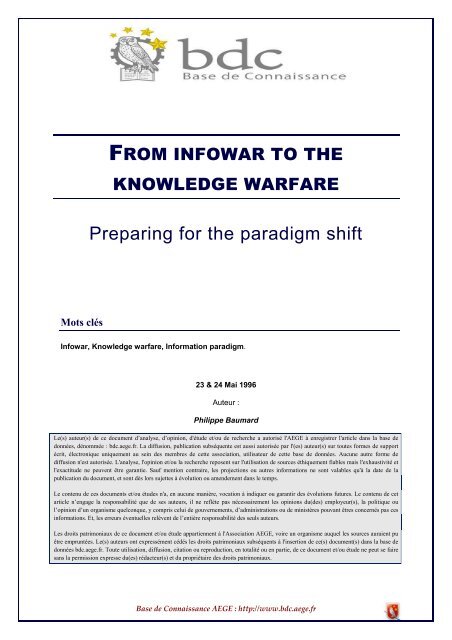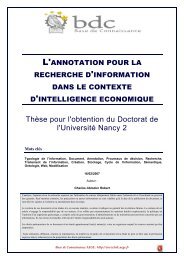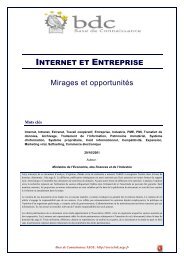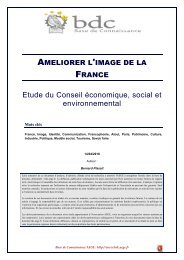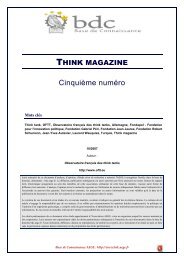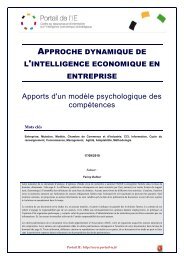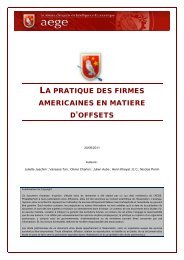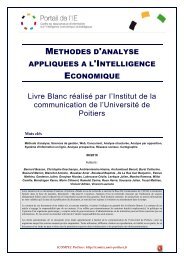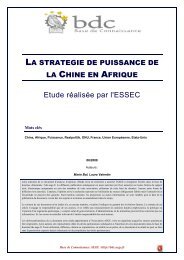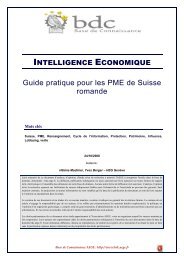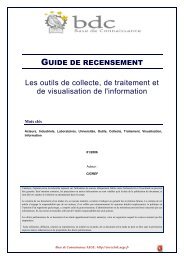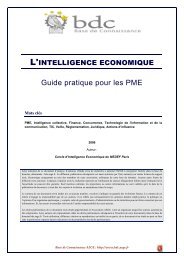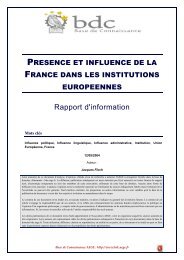From infowar to the knowledge warfare - Base de connaissance AEGE
From infowar to the knowledge warfare - Base de connaissance AEGE
From infowar to the knowledge warfare - Base de connaissance AEGE
Create successful ePaper yourself
Turn your PDF publications into a flip-book with our unique Google optimized e-Paper software.
FROM INFOWAR TO THEKNOWLEDGE WARFAREPreparing for <strong>the</strong> paradigm shiftWe will argue in this paper that InfoWar - informational arena-based <strong>warfare</strong> - hasbeen thought within <strong>the</strong> boundaries of old schemata that will no longer be accurate in<strong>the</strong> XXI st century.Mots clésInfowar, Knowledge <strong>warfare</strong>, Information paradigm.23 & 24 Mai 1996Auteur :Philippe BaumardLe(s) auteur(s) <strong>de</strong> ce document d’analyse, d’opinion, d'étu<strong>de</strong> et/ou <strong>de</strong> recherche a au<strong>to</strong>risé l'<strong>AEGE</strong> à enregistrer l'article dans la base <strong>de</strong>données, dénommée : bdc.aege.fr. La diffusion, publication subséquente est aussi au<strong>to</strong>risée par l'(es) auteur(s) sur <strong>to</strong>utes formes <strong>de</strong> supportécrit, électronique uniquement au sein <strong>de</strong>s membres <strong>de</strong> cette association, utilisateur <strong>de</strong> cette base <strong>de</strong> données. Aucune autre forme <strong>de</strong>diffusion n'est au<strong>to</strong>risée. L'analyse, l'opinion et/ou la recherche reposent sur l'utilisation <strong>de</strong> sources éthiquement fiables mais l'exhaustivité etl'exactitu<strong>de</strong> ne peuvent être garantie. Sauf mention contraire, les projections ou autres informations ne sont valables qu'à la date <strong>de</strong> lapublication du document, et sont dès lors sujettes à évolution ou amen<strong>de</strong>ment dans le temps.Le contenu <strong>de</strong> ces documents et/ou étu<strong>de</strong>s n'a, en aucune manière, vocation à indiquer ou garantir <strong>de</strong>s évolutions futures. Le contenu <strong>de</strong> cetarticle n’engage la responsabilité que <strong>de</strong> ses auteurs, il ne reflète pas nécessairement les opinions du(<strong>de</strong>s) employeur(s), la politique oul’opinion d’un organisme quelconque, y compris celui <strong>de</strong> gouvernements, d’administrations ou <strong>de</strong> ministères pouvant êtres concernés pas cesinformations. Et, les erreurs éventuelles relèvent <strong>de</strong> l’entière responsabilité <strong>de</strong>s seuls auteurs.Les droits patrimoniaux <strong>de</strong> ce document et/ou étu<strong>de</strong> appartiennent à l'Association <strong>AEGE</strong>, voire un organisme auquel les sources auraient puêtre empruntées. Le(s) auteurs ont expressément cédés les droits patrimoniaux subséquents à l'insertion <strong>de</strong> ce(s) document(s) dans la base <strong>de</strong>données bdc.aege.fr. Toute utilisation, diffusion, citation ou reproduction, en <strong>to</strong>talité ou en partie, <strong>de</strong> ce document et/ou étu<strong>de</strong> ne peut se fairesans la permission expresse du(es) rédacteur(s) et du propriétaire <strong>de</strong>s droits patrimoniaux.<strong>Base</strong><strong>de</strong>Connaissance<strong>AEGE</strong>:http://www.bdc.aege.fr
<strong>From</strong> Infowar <strong>to</strong> <strong>knowledge</strong> <strong>warfare</strong>:preparing for <strong>the</strong> paradigm shiftPhilippe BAUMARD, Cahier <strong>de</strong> recherche, article présenté à : The FourthInternational Conference on Information Warfare: Defining <strong>the</strong> EuropeanPerspective, Bruxelles, Belgique, 23-24 mai 1996. et publié dans Cyberwar:Security, Strategy and Conflict in <strong>the</strong> Information Age, A. Campen, D. Dearth,R. Goo<strong>de</strong>n (edi<strong>to</strong>rs), Fairfax, Virginia: Armed Forces Communications andElectronics Association, International Press, 1996, pp. 147-160.Successful firms, such as Intel, maintain an innovative environment, seek continuousperformance improvement, favor cus<strong>to</strong>mer orientation (e.g. through partnerships withcus<strong>to</strong>mers and suppliers), enhance results orientation, and place speed of creation, <strong>de</strong>fense and<strong>de</strong>velopment of value-chains at <strong>the</strong> core of <strong>the</strong>ir strategic focus. To maintain its lea<strong>de</strong>rship,Intel <strong>de</strong>veloped "war rooms", and encouraged informal relationships that crisscrossedorganizational boundaries. Never<strong>the</strong>less, when Intel had <strong>to</strong> face InfoWar practices, it had <strong>to</strong>ac<strong>knowledge</strong> that <strong>the</strong> company failed <strong>to</strong> prevent and <strong>to</strong> anticipate large-scale Info<strong>de</strong>stabilization.New businesses live on <strong>the</strong> brink of disasters. Yet, "organizations have many stabilizers butquite often lack proper <strong>de</strong>stabilizers". We will argue in this paper that InfoWar —informational arena-based <strong>warfare</strong> — has been thought within <strong>the</strong> boundaries of old schematathat will no longer be accurate in <strong>the</strong> XXI st century. These schemata inclu<strong>de</strong>s misconceptionsof management, organizations, economics, welfare and of purpose of <strong>de</strong>velopment.We will investigate, in <strong>the</strong> footsteps of Hedberg, Jönsson, Starbuck, Steele, Wilensky, andmany o<strong>the</strong>rs, <strong>de</strong>sign principles that worked, and no longer worked. Founding our commentson observations of real-world experiences, we end with recommendations as <strong>to</strong> preparenations, organizations and people for <strong>the</strong> forthcoming paradigm shift: from InfoWar <strong>to</strong>Knowledge Warfare (K-Warfare).Why Policy Makers Got Trapped in <strong>the</strong> Information ParadigmWorld lea<strong>de</strong>rs, who mostly belong <strong>to</strong> a generation that is not born with a computer at home,has been strongly influenced by cybernetics. In a cybernetic world, economic and social life isseen as a system ; values are categorized ; economic systems are mo<strong>de</strong>led ; social structuresare typologized, and i<strong>de</strong>ologies are invented <strong>to</strong> put all <strong>the</strong>se systems <strong>to</strong>ge<strong>the</strong>r. In such a world,policy makers are not long <strong>to</strong> assume that information is power, and systematizedinformation, <strong>the</strong> structure of power itself.His<strong>to</strong>ry has been, so far, consistent with such implicit assumptions. Power was centralized,and, <strong>the</strong>refore, nee<strong>de</strong>d centralized intelligence. The world was organised in<strong>to</strong> blocks, and<strong>the</strong>refore, nee<strong>de</strong>d compartmented information. Economic and social systems werehierarchical, and <strong>the</strong>refore, hierarchical information ma<strong>de</strong> sense.<strong>From</strong> <strong>the</strong> starting point, this cybernetic view of <strong>the</strong> world was quite erroneous. As Varela andMaturana pointed out, neurons that participate in <strong>the</strong> building of "vision" only account for1
20% from <strong>the</strong> eyes' retinas, whereas 80% of <strong>the</strong>m come from o<strong>the</strong>r parts of <strong>the</strong> brain. In o<strong>the</strong>rwords, 80% of our "vision" is internally constructed. Vision is mostly <strong>knowledge</strong>, notinformation. Fur<strong>the</strong>rmore, this <strong>knowledge</strong> is mostly tacit ; it escapes our individual orcollective awareness.Eventually, people — including policy-makers — learn without being aware of what is beinglearned ; co<strong>de</strong> without being aware of coding ; and most dramatically, learn without havinginten<strong>de</strong>d or planned <strong>to</strong> learn. Most learning is inci<strong>de</strong>ntal.Emerging "Information Warfare" doctrines fail <strong>to</strong> ac<strong>knowledge</strong> this fragility of learning.Mapping without knowing is a non-sense. Mapping, as an act of "vision", is mostly <strong>de</strong>rivedfrom <strong>the</strong>se 80% of neurons, in our brains and not in our retinas, that participate in <strong>the</strong>construction of images, and help us <strong>to</strong> transform noticed and unnoticed stimuli in<strong>to</strong> sensemaking.Such weapons as "private-sec<strong>to</strong>r communication satellite constellations that instantlylink individuals, on-<strong>de</strong>mand high-resolution imaging spacecraft and rapidly evolvinggigabit/sec.-class networks" are no less than phantasmagorias, if we neglect <strong>to</strong> take care of<strong>the</strong>se disturbing, — yet remaining —, au<strong>to</strong>nomous neurons of our brains.A small firm of less than 12 employees, named "Indigo", is an exemplar. Indigo produces andpublishes five confi<strong>de</strong>ntial newsletters, including <strong>the</strong> Intelligence Newsletter, a well-reputesource of intelligence among policy makers in Europe. Myths and rumors circulate, seeing inIndigo's high accuracy a ploy of obscure foreign intelligence. French rea<strong>de</strong>rs suspect foreignintrusions. Foreign rea<strong>de</strong>rs suspect French manipulation. In fact, Indigo is nothing else thanan efficient "<strong>knowledge</strong>-refinery", that is <strong>to</strong> say a firm purposefully <strong>de</strong>signed for <strong>the</strong>efficiency of its <strong>knowledge</strong> generation. In-site observation shows that "far from being pliable,<strong>knowledge</strong> generates its own path of transformation, while simultaneously transforming andbeing transformed by its organizational settings. An implication is that those who wouldmanage <strong>knowledge</strong> should respect this propensity for au<strong>to</strong>nomous <strong>de</strong>velopment". Cautious<strong>to</strong>wards systematized information ga<strong>the</strong>ring, Indigo's staff is operating within a "communityof practice" — i.e. an intensive and highly-contextualized socialization process —, and favorsHUMINT. The whole organization is focused on sense-making instead of informationcollection.Intensity and <strong>de</strong>pth of internal and external socializations are consi<strong>de</strong>red as <strong>the</strong>core organizational competitive advantage. The rate of <strong>de</strong>faults is close <strong>to</strong> zero. The overallperformance, in terms of growth and ROI, is twice higher that similar organizations such as<strong>the</strong> The Economist Intelligence Unit.To un<strong>de</strong>rstand such a performance, let us remind that information is not <strong>knowledge</strong>, and <strong>the</strong>nlet us investigate how <strong>to</strong> <strong>de</strong>al with <strong>knowledge</strong>, instead of information. As general Franckspointed out, "Vietnam was <strong>the</strong> first battlefield use of computers. The Univac 1005, which <strong>the</strong>25th infantry division installed in 1966 at Cu Chi, filled an entire van (…) Images of <strong>the</strong>enemy and terrain were captured with conventional cameras and television with lightintensification <strong>de</strong>vices, radar, and infrared <strong>de</strong>vices. Sensors and high altitu<strong>de</strong> re<strong>connaissance</strong>scanned 100,000 square miles per hour providing comman<strong>de</strong>rs with a here<strong>to</strong>fore unknownview of <strong>the</strong> battlefield". Meanwhile, Vietnamese population was digging un<strong>de</strong>rgroundtunnels. Similarly, French Foreign Legion was settling its command outposts on hills, as <strong>to</strong>dominate battlefields, and meanwhile, Vietnamese soldiers were digging <strong>the</strong> crops andburying <strong>the</strong>mselves in <strong>the</strong> face and "vision" of <strong>the</strong> enemy… Proving, if necessary, thatneurons from <strong>the</strong> retinas only account for 20% of vision. What was dramatically missing wasnot information, but <strong>knowledge</strong> in general, and an a<strong>de</strong>quate form of "knowing" in particular."We are on <strong>the</strong> threshold of an era where or<strong>de</strong>r can be achieved largely through <strong>knowledge</strong>…2
not necessarily through physical or<strong>de</strong>r"Knowledge vs. Information, Knowing vs. KnowledgeUn<strong>de</strong>rstanding <strong>the</strong> differences between '<strong>knowledge</strong>' and 'knowing' is essential <strong>to</strong> a successfulentry in this new paradigm. "One contemporary cliché is that more and more turbulentsettings are requiring organizations <strong>to</strong> use more and more <strong>knowledge</strong>, and that this in turnforces organizations <strong>to</strong> process more and more information". A <strong>knowledge</strong>-base is all <strong>the</strong>learning of people and institutions more or less explicitly encapsulated in minds, brains,mo<strong>de</strong>ls, signals, culture, rules, gui<strong>de</strong>lines. Greek philosophers used <strong>to</strong> categorize this human<strong>knowledge</strong> in three ensembles : <strong>the</strong> techne, <strong>the</strong> embodied technical know-how ; <strong>the</strong> episteme,<strong>the</strong> abstract generalization <strong>de</strong>rived from knowing-how, and <strong>the</strong> phronesis, <strong>the</strong> wisdom ofsocial practice, i.e. <strong>the</strong> ability <strong>to</strong> <strong>de</strong>rive aggregates from social learning. In mo<strong>de</strong>rnmanagement literature, <strong>the</strong> investigation of <strong>knowledge</strong> within and in-between organizations ismerely <strong>de</strong>rived from <strong>the</strong> same twenty-four centuries old conceptualization. The conventionalview is that <strong>the</strong> relevant <strong>knowledge</strong> comes from explicit situational analysis, i.e. it is objective<strong>knowledge</strong>. As Detienne and Vernant pointed out, education in <strong>the</strong> Ju<strong>de</strong>o-Christian world hasbeen strongly influenced by <strong>the</strong> pursuit of Truth as <strong>the</strong> sole goal of <strong>knowledge</strong> generation.Starting in 400 BC., <strong>knowledge</strong> is systematically un<strong>de</strong>rs<strong>to</strong>od as "objective <strong>knowledge</strong>",leaving 'meaner' forms of <strong>knowledge</strong> and knowing, — such as conjectural <strong>knowledge</strong> —,disregar<strong>de</strong>d and low-gra<strong>de</strong>. The governmental intelligence cycle itself is a pursuit of objective<strong>knowledge</strong>. Intelligence generation is driven by an objectivation force, that discards unreliableinformation and sources according <strong>to</strong> truth-setting rules. As Wilensky put it, <strong>the</strong> intelligencebodies are overcrow<strong>de</strong>d with "facts-and-figures men", who "introduce a 'rational-responsible'bias" (…) "Facts-and-figures men are preoccupied with rational argument and criteria; <strong>the</strong>irtechnical competence compels opposing parties <strong>to</strong> be more careful or honest in <strong>the</strong>ir use ofinformation, <strong>to</strong> match each o<strong>the</strong>r expert for expert, fact for fact". Thus, current doctrines ofInfoWar are all implicitly based on a biased assumption that large-scale truth seeking issuperior <strong>to</strong> <strong>de</strong>pth and differentiation of knowing mo<strong>de</strong>s. Such doctrines are based on <strong>the</strong> beliefthat <strong>the</strong> process of organizations and nation's 'getting in<strong>to</strong> difficulties' is essentially one of <strong>the</strong><strong>de</strong>gradation and increasing disutility of <strong>the</strong>ir <strong>knowledge</strong>-base. Yet, when doctrine genera<strong>to</strong>rsare asked <strong>to</strong> <strong>de</strong>fine such a "<strong>knowledge</strong>-base", <strong>the</strong>y have <strong>to</strong> face <strong>the</strong>ir incapacity <strong>to</strong> <strong>de</strong>scribeand <strong>to</strong> qualify it.Knowledge-base, as a matter of fact, is a static concept. It assumes that <strong>knowledge</strong> can besystematically put in <strong>the</strong> form of a representation, and neglects all various forms of tacit<strong>knowledge</strong> in general, and collective tacit <strong>knowledge</strong>, in particular. Thus, <strong>the</strong> same Ju<strong>de</strong>o-Christian bias applies <strong>to</strong> <strong>the</strong> representation of <strong>knowledge</strong>. Knowledge is assumed <strong>to</strong> be merelya long-term representation ; is seen as a commodity ; is talked in terms of volume and s<strong>to</strong>cks ;is <strong>de</strong>scribed with a vocabulary borrowed <strong>to</strong> hardware management. In such a biasedconception of <strong>knowledge</strong>, one usually distinguish short-term, or procedural, representationsthat can be immediately acted on one si<strong>de</strong>, and long-term, or structural, representations,whose access and <strong>de</strong>velopment need several apprenticeships.As a consequence, focus should be put on <strong>the</strong> advancement of "knowing", instead of <strong>the</strong>accumulation of "<strong>knowledge</strong>". Development of national intelligence capabilities should<strong>the</strong>refore target <strong>the</strong> improvement of interpretational and sense-making skills, instead ofpursuing <strong>the</strong> u<strong>to</strong>pia of <strong>the</strong> ubiquity of a <strong>knowledge</strong> seen as a commodity. Such a self<strong>de</strong>ceptionhas its roots in <strong>the</strong> reproducibility of information. Redundancy of information is aserious waste of resources in most industrial <strong>de</strong>mocracies. For instance, in France, no less3
than 80 administrative bodies distribute <strong>to</strong> small and large businesses <strong>the</strong> same informationagain and again. This redundant information eventually leads <strong>to</strong> redundant intelligenceadministrations, leading <strong>to</strong> <strong>the</strong> hypertrophy of bureaucratic, and inefficient, intelligencebodies. The 1996 reorganization of <strong>the</strong> U.S. Intelligence Community is an exemplar of thislack of focus on "knowing" capabilities, and of <strong>the</strong> exaggerated attention given <strong>to</strong> <strong>the</strong>accumulation of "<strong>knowledge</strong>". In 1992, Ernest R. May "urges <strong>the</strong> Committee <strong>to</strong> think ofindividuals in <strong>the</strong> Intelligence Community as well as of <strong>the</strong>ir organizational boxes". FrankCarlucci, a former Assistant <strong>to</strong> <strong>the</strong> Presi<strong>de</strong>nt for National Security Affairs, un<strong>de</strong>rlines that"Congress could ren<strong>de</strong>r a valuable service if it would lead <strong>the</strong> Intelligence Communitythrough <strong>the</strong> process of cultural change that many of our businesses have gone through". AsOr<strong>to</strong>n and Callahan noted, "unwarranted duplication remains a problem; and intelligenceremains <strong>to</strong>o isolated from <strong>the</strong> governmental process it was created <strong>to</strong> serve".The focus on "<strong>knowledge</strong> as a commodity" vs. <strong>the</strong> "improvement of knowing" can also beobserved in <strong>the</strong> conceptual frameworks that are judged <strong>to</strong> be a good basis for <strong>knowledge</strong>based<strong>warfare</strong>. Col. Steven J. Sloboda, formerly in charge of long-range planning for U.S.Space Command asserts: "Space is literally <strong>the</strong> fabric upon which we will weave ourapproach <strong>to</strong> <strong>knowledge</strong>-based <strong>warfare</strong>. Space is <strong>the</strong> enabling ingredient… Fortunately, <strong>the</strong>convergence of our experience in space operations, communications networking, andinformation processing seems <strong>to</strong> make <strong>the</strong> move <strong>to</strong> <strong>knowledge</strong>-based <strong>warfare</strong> achievable".Unfortunately, human souls and minds are not fully readable from outer space. The "folk<strong>the</strong>ory" that trust moves not words might well be misleading in a <strong>knowledge</strong>-based paradigm.The Vietnam, Gulf and former Yugoslavia experiences — three mo<strong>de</strong>rn war <strong>the</strong>aters withintensive use of satellite information — are exemplar cases of <strong>the</strong> limits of satellitecar<strong>to</strong>graphy in penetrating human intents. Moreover, such experiences un<strong>de</strong>rline <strong>the</strong> limits ofInfoWar. As Dragnich noted, <strong>the</strong> "so-called information war" that has been proposed "<strong>to</strong> wageagainst <strong>the</strong> Serbs is ridiculous. The Serbs do not need <strong>the</strong> outsi<strong>de</strong> world <strong>to</strong> tell <strong>the</strong>m thatcommunism and Slobodan Milosevic are bad"Misconceptions of managementThus, management should be <strong>de</strong>signed and un<strong>de</strong>rs<strong>to</strong>od as primarily a <strong>knowledge</strong>-generationprocess. Many companies tend <strong>to</strong> follow management practices that take <strong>the</strong> physical worldfor granted. When <strong>the</strong> Berlin Wall fell, Finland believed that <strong>the</strong> announced geostrategic shiftwould require <strong>the</strong> acquisition of combat fighters. The market was estimated at around US$ 3billions. Four French companies, Snecma, Matra, Dassault and Thomson, and <strong>the</strong> DefenseAdministration <strong>de</strong>ci<strong>de</strong> <strong>to</strong> enter <strong>the</strong> race for this competitive bid. When <strong>the</strong> newly settledFrench Economic Intelligence and Corporate Strategies Commission, at <strong>the</strong> French Office ofPlanning, <strong>de</strong>ci<strong>de</strong>d <strong>to</strong> <strong>de</strong>velop a few exemplar case studies, <strong>the</strong> case of <strong>the</strong> Mirage 2000-5 wasselected. The audit revealed that lack of coordination and <strong>knowledge</strong> sharing was at <strong>the</strong> rootsof <strong>the</strong> commercial failure. Managers who negotiated <strong>the</strong> contract were chosen according <strong>to</strong>corporate criteria. Internal competition prevented any attempt of crisscrossed <strong>knowledge</strong>transfers. Ano<strong>the</strong>r French firm, <strong>the</strong> Aerospatiale, which has an in-<strong>de</strong>pth <strong>knowledge</strong> of <strong>the</strong>Finland aeronautics market was not consulted by <strong>the</strong> competing pool. In <strong>the</strong> absence of along-term <strong>knowledge</strong> strategy, <strong>the</strong> State was unable <strong>to</strong> display any capitalization of<strong>knowledge</strong> on Finland. The lack of longitudinal capitalization of geostrategic <strong>knowledge</strong> led<strong>to</strong> <strong>the</strong> incapability of <strong>de</strong>signing required distinctive attributes in <strong>the</strong> competitive bid. In <strong>the</strong>middle of <strong>the</strong> negotiation process, <strong>the</strong> political turmoil in Finland was perceived as anobstacle, whereas <strong>the</strong> American companies reinforced <strong>the</strong>ir coordination and lobbying <strong>to</strong> use<strong>the</strong>se elections as a leverage for <strong>the</strong>ir offer. In<strong>de</strong>ed, <strong>the</strong> French consortium was competing4
with a hypo<strong>the</strong>tical F-16 offer, while <strong>the</strong> American were proposing <strong>the</strong> F-18. As Wilenskywarned, "in all complex social systems, hierarchy, specialization, and centralization are majorsources of dis<strong>to</strong>rtion and blockage of intelligence".However, it seems that this analysis can be put a step forward. In this intelligence failure, <strong>the</strong>main cause was <strong>the</strong> inappropriateness of management practices <strong>to</strong> a non-market environment.The French consortium failed <strong>to</strong> recognize and ac<strong>knowledge</strong> forces that acted outsi<strong>de</strong> <strong>the</strong>narrow bor<strong>de</strong>rs of <strong>the</strong> targeted market. In a transversal environment (i.e. that impliesgeopolitical, geoeconomical, local politics, technology and society), with a transversal offer(i.e. typically a consortium of different firms, proposing dual technologies), traditional"market management" fails <strong>to</strong> grab critical issues. As R.D. Laing noted, <strong>the</strong> range of what wethink and do is limited by what we fail <strong>to</strong> notice… If non-market <strong>knowledge</strong> is not integratedin management duties and skills, it is bound <strong>to</strong> be neglected. Thus, "non-market strategiesresult from a management process that incorporates <strong>knowledge</strong> of <strong>the</strong> market and nonmarketenvironments, information about specific issues, and conceptual frameworks that gui<strong>de</strong>strategy formulation and implementation".Misconceptions of organizationsMost organizations are unfit for <strong>the</strong> management and capitalization of intangible assets ingeneral, and counter-productive in terms of <strong>knowledge</strong> generation. However true one "mustanalyze <strong>the</strong> flow of information along <strong>the</strong> value chain as well as <strong>the</strong> movement of goods", itmight be quite insufficient <strong>to</strong> cope with <strong>the</strong> new conditions of competitiveness.The whole concept of value-chain, and <strong>the</strong> education given <strong>to</strong> managers on that matter, shouldbe revised. Managers and scholars are used <strong>to</strong> thinking of organizations as stable contractualbodies, with physical locations (headquarters, plants, <strong>de</strong>partments, etc.), while <strong>the</strong> neweconomics call for a focus on industries as systems, ra<strong>the</strong>r than buildings and walls. BoHedberg introduces <strong>the</strong> concept of "imaginary organizations" <strong>to</strong> picture <strong>the</strong>se new economicconditions.An "imaginary organization" is a <strong>knowledge</strong>-infrastructure concerning markets, potentialopportunities for production and creation of value-chains. Hedberg uses <strong>the</strong> example of Gant,an American garment brand that was bought by Swedish inves<strong>to</strong>rs, and <strong>de</strong>veloped worldwi<strong>de</strong>.Gant has no proprietary plants. The whole organization consists of a team of managers thatcoordinate market needs and channels with a constellation of in<strong>de</strong>pen<strong>de</strong>nt suppliers. The corecompetitive advantage of Gant lies in <strong>the</strong> corporation's ability <strong>to</strong> coordinate market needs within<strong>de</strong>pen<strong>de</strong>nt systems' inputs. Gant uses its <strong>knowledge</strong> infrastructure <strong>to</strong> <strong>de</strong>fine and findmatches between in<strong>de</strong>pen<strong>de</strong>nt production and <strong>de</strong>sign capabilities and market needs.This whole perspective of "<strong>knowledge</strong> infrastructures" is likely <strong>to</strong> be <strong>the</strong> dominant paradigmin <strong>the</strong> coming century. Hewlett Packard in France got rid of local middle managementsupervisory staff <strong>to</strong> replace it with a centralized information platform at its headquarters. The"information infrastructure" collects cus<strong>to</strong>mers' needs and requests, and dispatches <strong>the</strong>information directly <strong>to</strong> managers and maintenance engineers' notebook screens throughElectronic Data Interchange. Locally, Hewlett Packard suppressed many subsidiaries andbranches. Managers and maintenance engineers work at home, being constantly on <strong>the</strong> move<strong>to</strong> meet cus<strong>to</strong>mers' needs and specifications on sites. The whole organization is transformed ina <strong>knowledge</strong>-generation no<strong>de</strong>, with many peripheries where action is taking place.5
Could such a mo<strong>de</strong>l be implemented on a national scale, and what would be social andwelfare consequences? It is quite probable that such a "<strong>knowledge</strong> infrastructure" could be<strong>de</strong>signed and implemented on a national scale. It would require administrations, large andsmall corporations and individuals <strong>to</strong> share a communal information infrastructure where<strong>de</strong>mands and supplies of tangibles and intangibles would find <strong>the</strong>ir matches. In such aperspective, competitive advantage of nations would eventually lie in national ability andspeed <strong>to</strong> generate (and discontinue without social and economic costs) virtual value chains <strong>to</strong>operate <strong>the</strong>m. Attempts such as <strong>the</strong> Department of Commerce's Advocacy Center in <strong>the</strong>United States, and <strong>the</strong> Committee for Economic Security and Competitiveness (CCSE)attached <strong>to</strong> <strong>the</strong> Secretariat General <strong>de</strong> la Defense National (SGDN) in France, are evi<strong>de</strong>ntlypursuing such a mo<strong>de</strong>l.Both <strong>the</strong> Advocacy Center and <strong>the</strong> CCSE pursue an objective of coordination and alertnessbetween administrative bodies and private organizations. However, while <strong>the</strong> AdvocacyCenter is located at an operational level with a direct link with <strong>the</strong> intelligence community,<strong>the</strong> French CCSE is placed un<strong>de</strong>r <strong>the</strong> authority of <strong>the</strong> Prime Minister, and its main focus is asupra-coordination of administrative bodies (Ministries of Finances, Defense, Foreign Affairs,French Office of Planning…) that already fulfill, more or less properly, a coordination role.Political ambitions, in France and in <strong>the</strong> United States, and intelligence communities' internalconflicts, are however impeding <strong>the</strong> performance of both <strong>the</strong> French and Americanexperiences.Misconceptions of economics & welfareEconomics <strong>the</strong>ories mainly failed, for <strong>the</strong>y ei<strong>the</strong>r never succee<strong>de</strong>d <strong>to</strong> address <strong>the</strong> benevolenceissue in economic <strong>de</strong>velopment, or rapidly lost its focus when attempting <strong>to</strong> grab it. Mythsthat surround <strong>the</strong> <strong>de</strong>velopment of InfoWar or InfoEconomics, are mainly myths ofmalevolence: 'cyberwarriors', 'viruses', 'logic bombs', etc. Whereas we leave <strong>the</strong> paradigm ofeconomics of forces, physical or<strong>de</strong>r, heaviness and superiority of gen<strong>de</strong>r on genius, we tend <strong>to</strong>bring with us <strong>the</strong> bad habits of past and his<strong>to</strong>ry. InfoWar experts and analysts react <strong>to</strong> <strong>the</strong>emergence of <strong>the</strong> '<strong>knowledge</strong> paradigm' with a <strong>de</strong>fense attitu<strong>de</strong> <strong>to</strong>wards <strong>the</strong> unexpected.Whereas a global <strong>knowledge</strong> infrastructure could have been an opportunity <strong>to</strong> substitute athreat-equilibrium with 'integrative power', policy-makers tend <strong>to</strong> project i<strong>de</strong>ologies anddoctrines that proved <strong>to</strong> be wrong, instead of inventing <strong>the</strong> conceptual framework that will fit<strong>the</strong> new economics.Two biases lie behind <strong>the</strong> <strong>de</strong>sign and mission of <strong>the</strong>se governmental-level informationcoordination bodies. The first bias could be pictured as an "intelligentsialization" of <strong>the</strong>information infrastructure. Both governments have chosen a <strong>to</strong>p-down implementation of<strong>the</strong>ir information infrastructure, thus applying obsolete governmental schemata <strong>to</strong> <strong>the</strong>management of <strong>knowledge</strong>. While experts are calling for <strong>the</strong> <strong>de</strong>velopment of <strong>the</strong> largest"<strong>knowledge</strong> sharing culture", national <strong>knowledge</strong>-infrastructure projects are being drawn withan elitist buyest. It might occur, around 2010, that such <strong>de</strong>cisions were his<strong>to</strong>rical self<strong>de</strong>ceptions.Doing so, governments tend <strong>to</strong> confuse information logistics (a structuralperspective) with <strong>knowledge</strong> sharing (an interactionist perspective). In o<strong>the</strong>r words, artificialefficiency is reached <strong>to</strong>day because <strong>de</strong>cision makers and policy makers who share informationalready hold <strong>the</strong> requisite <strong>knowledge</strong> <strong>to</strong> make this information actionable. Thus, it gives <strong>the</strong>illusion that <strong>the</strong> <strong>de</strong>velopment of an information structure is a necessary and sufficientcondition <strong>to</strong> attain a national <strong>knowledge</strong> infrastructure.6
On <strong>the</strong> contrary, such a policy will prove <strong>to</strong> be counter-productive. It will eventually create anisolated body of upper-level <strong>knowledge</strong>, disconnected with <strong>the</strong> reality of social <strong>de</strong>velopmentand learning, and <strong>the</strong>refore, increasing <strong>the</strong> gap between people who act, learn and talk, andpeople being acted, learned and talked. Economic performance might be reached through anroutinized logistics of generic <strong>knowledge</strong> amongst business lea<strong>de</strong>rs, industrialists andpoliticians, but social performance is already doubtful. Research findings suggest thatpermanent improvement and continuous learning cannot be achieved in situations ofdisarticulated socialization. Information infrastructures, as <strong>de</strong>signed in American and Frenchprojects, favor information exchange, including possible use of information highways, andneglect <strong>to</strong> <strong>de</strong>sign proper socialization <strong>de</strong>vices that would enhance permanent and collectivesense-making. Fur<strong>the</strong>rmore, such <strong>knowledge</strong> infrastructures are already perceived by <strong>the</strong>population as jobs-<strong>de</strong>structive, in opposition with almost all fourteen points of Deming'sprinciples of continuous transformation. One of <strong>the</strong>se principles says that fear should bedriven out, so that everyone may work effectively. Surroun<strong>de</strong>d by myths of malevolence,economic intelligence sharing-infrastructures, on <strong>the</strong> contrary, announces a quest foreconomics of coordination costs, worldwi<strong>de</strong> economics of scale, and <strong>the</strong> birth of a<strong>knowledge</strong>able elite, with privileged and discretionary access <strong>to</strong> uprising <strong>knowledge</strong>infrastructures. Hewlett Packard was an examplar on that point. Local managers disappeared,leaving <strong>the</strong>ir place <strong>to</strong> management technicians "being acted" by electronic data interchange.Many firms, more or less consciously, <strong>to</strong>ok this curve. Asea Brown Bovery (ABB) reduced itscorporate staff, after its fusion, from more than 4000 <strong>to</strong> less than 300 "global managers".Given <strong>the</strong> fact that middle managers already live and work in suburban areas, effect is anincreasing gap between geographically-concentrated conceptual <strong>knowledge</strong>, andgeographically-dispersed procedural know-how. Instead of encouraging a cooperative culture,<strong>knowledge</strong> infrastructures may implement a perennial rupture between an exclusive and verysmall <strong>knowledge</strong>able suprastructure, and a very large, fragmented and <strong>de</strong>socialized,cognitively-taylorized substructure.In Deming's <strong>the</strong>ory, effectiveness is <strong>de</strong>rived from continuous efforts "<strong>to</strong>ward <strong>the</strong> simultaneouscreation of cooperative and learning organization <strong>to</strong> facilitate <strong>the</strong> implementation of processmanagementpractices, which, when implemented, support cus<strong>to</strong>mer satisfaction andorganizational survival through sustained employee fulfillment and continuous improvemen<strong>to</strong>f processes, products, and services". Similar thinking can be found in intelligence his<strong>to</strong>ry ingeneral, and in <strong>the</strong> XVIth century Elizabethan doctrine of governmental intelligence inparticular: "Elizabeth was intellectually <strong>the</strong> most enlightened monarch of her time. FrancisBacon writes that she was "undued with learning," and "<strong>to</strong> <strong>the</strong> end of her life she sets hoursfor reading… (more than) scarcely any stu<strong>de</strong>nt of her time". One way <strong>to</strong> please her was <strong>to</strong> talk"In Praise of Knowledge", as Essex did with his essay, most probably written by Bacon".Queen Elizabeth I's intelligence shadow adviser, Sir Francis Bacon, was <strong>the</strong> author of <strong>the</strong>Advancement of Learning in 1605, and also authored an essay entitled "Followers andFriends" in 1597. The o<strong>the</strong>r intelligence doctrine advisor, Sir William Cecil, authored on hispart, of a forward-looking memorandum entitled Matters Necessary <strong>to</strong> be Done, Troubles…that all May Presently Ensue, Things Necessary <strong>to</strong> be Consi<strong>de</strong>red, With Speed, withForeboding, With Foresight, Plots and Designs. Speed, consistency and sharing of<strong>knowledge</strong>-generation processes on a large-scale base were already put at <strong>the</strong> center ofnational <strong>de</strong>velopment strategies.The difference between 16th century Great Britain and current industrial <strong>de</strong>mocracies,however, is a fundamental shift from obedience <strong>to</strong> commitment of <strong>the</strong> governed. To continue<strong>to</strong> <strong>de</strong>sign information infrastructures in <strong>the</strong> Elizabethan style, is overlooking that <strong>knowledge</strong> is7
nowadays wi<strong>de</strong>ly distributed. "Cooperation, in this context, is synonymous with collaborationamong different individuals, groups, or organizations, where all entities are engaging innoncompetitive, mutually beneficial, win-win activities".Why Shifting from I-War <strong>to</strong> K-War: A case-studyAs Wilensky once put it, "information has always been a source of power, but it is nowincreasingly a source of confusion. In every sphere of mo<strong>de</strong>rn life, <strong>the</strong> chronic condition issurfeit of information, poorly integrated or lost somewhere in <strong>the</strong> system". Roots of suchfailures can been found (a) in <strong>the</strong> persistent confusion between <strong>knowledge</strong> and information,(b) on <strong>the</strong> large-scale focus that has been given in education <strong>to</strong> cumulating of <strong>knowledge</strong>basesvs. permanent improvement of <strong>the</strong> diversity and flexibility of mo<strong>de</strong>s of knowing, and(c) in <strong>the</strong> failure of scientists in integrating in new organizational forms and purposes, <strong>the</strong>advancements of social cognition and collective learning. Yet, "managers are becomingincreasingly aware that informed adaptability is at a premium and <strong>to</strong> attain it <strong>the</strong>y may needdifferent mo<strong>de</strong>s of organization <strong>to</strong> find and solve different types of problems". Never<strong>the</strong>less,and consistent with a perception of <strong>knowledge</strong> as a commodity, "organization" on one si<strong>de</strong>,and "<strong>knowledge</strong>' on <strong>the</strong> o<strong>the</strong>r si<strong>de</strong>, are systematically approached distinctively. Organization<strong>the</strong>orists propose many alternatives and original organizational forms, but leave managerswith <strong>the</strong> duty of generating a<strong>de</strong>quate <strong>knowledge</strong> <strong>to</strong> operate <strong>the</strong>m. Knowledge sociologists putmuch emphasis on <strong>the</strong> many forms of socializations that participate in <strong>the</strong> building ofcognitive skills, but are reluctant <strong>to</strong> study how organizational <strong>de</strong>sign and <strong>knowledge</strong>generation interact.German <strong>de</strong>finition of <strong>the</strong> world "Intelligenz" could shed some light on such an intricatedissue. The Wirtschafts-Lexikon, a principal German dictionary, in <strong>de</strong>fining intelligence, puts"an emphasis on mental processes geared <strong>to</strong> adaptation, integration, and recognizingsignificant relationships. These processes are interesting: were we <strong>to</strong> consi<strong>de</strong>r <strong>the</strong>m ascharacteristics of some organizational form, we would come very near <strong>to</strong> <strong>the</strong> 'intelligencesystem' <strong>de</strong>finition (…) German thought also recognizes <strong>the</strong> importance of <strong>the</strong> perception ofcausal connection and of capacity for combination". To achieve <strong>the</strong> integration of "knowing"and "organizing", German authorities have his<strong>to</strong>rically put a strong focus on <strong>the</strong> continuity ofeducation <strong>to</strong> intelligence in <strong>the</strong> society. After World War II, <strong>the</strong> Economic Police wasreintegrated in national industrial infrastructures. Today, German stu<strong>de</strong>nts receive educationfrom German Generals and Senior Military Officers in most business schools as <strong>to</strong> maintain alongitudinal awareness of <strong>the</strong> role played by intelligence and military art in <strong>the</strong> un<strong>de</strong>rstandingand <strong>de</strong>sign of business organizations.The Perrier case illustrates <strong>the</strong> importance of "<strong>the</strong> perception of causal connection and ofcapacity for combination", so much favored by German intelligence. On July 3, 1989, Perrierand Pepsi Co are negotiating <strong>the</strong> creation of a joint-venture, in which Perrier would hold 65%of <strong>the</strong> shares. The negotiations are disrupted on July 16. In August 1989, Perrier sells itssubsidiary, <strong>the</strong> Société Parisienne <strong>de</strong> Boissons Gazeuses, which distributes PepsiCo in France<strong>to</strong> its main competi<strong>to</strong>r, Coca Cola. This competitive move is perceived as a retaliation. InNovember 1989, PepsiCo <strong>de</strong>nounces <strong>the</strong> poor performance of Perrier in <strong>the</strong> management ofits license, announcing <strong>the</strong> disruption of all contractual arrangements for December 1990.PepsiCo <strong>to</strong>ok Perrier <strong>to</strong> court on November 8, 1990 ; and announced, a day after, that it wouldbe eventually interested in taking over <strong>the</strong> soft-drinks activities of Perrier, if s<strong>to</strong>ck price wouldbe more attractive. Meanwhile, <strong>the</strong> Coca Cola s<strong>to</strong>ck reached <strong>the</strong> his<strong>to</strong>rical price of 72$ onNovember 18, 1989.8
On January 19, 1990, a labora<strong>to</strong>ry of North Carolina discovers traces of Benzene in samplesof Perrier mineral water. Experts suspect <strong>the</strong> information <strong>to</strong> have been transmitted through amole in Perrier production plant in Vergeze. "Causal connection" can be ma<strong>de</strong> between <strong>the</strong>test results, and <strong>the</strong> nearby location of a Coca Cola plant. The labora<strong>to</strong>ry Manager does notremember having replaced its test equipment, but "combined" information show strongevi<strong>de</strong>nce of all tests equipment being graciously replaced by a Coca Cola sponsoring of <strong>the</strong>labora<strong>to</strong>ry. On February 2, 1990, <strong>the</strong> Food and Drug Administration warns Perrier thatmineral water being distributed in <strong>the</strong> United States contains Benzene.At that time, Perrier is a potential target for a take-over. Nestle would eventually beinterested, and has ma<strong>de</strong> aggressive competitive moves on <strong>the</strong> European market. In particular,Nestle has managed <strong>to</strong> sing an exclusivity with Walt Disney Europe ; walking on Coca Colatraditional proprietary terri<strong>to</strong>ry. On February 5, 1990, <strong>the</strong> Food and Drug Administrationconfirms <strong>the</strong> presence of Benzene in Perrier mineral water. On February 10, Perrier is forced<strong>to</strong> ac<strong>knowledge</strong>, but reacts very quickly by announcing that all bottles will be withdrawn from<strong>the</strong> market. On February 12, Perrier's s<strong>to</strong>ck is loosing 14%. Sun<strong>to</strong>ry, <strong>the</strong> Japanese distribu<strong>to</strong>rof <strong>the</strong> brand announces <strong>the</strong> withdrawal of 10.000 bottle cases from <strong>the</strong> Japanese market. OnFebruary 14, German authorities forbids Perrier mineral water on <strong>the</strong>ir markets. The FrenchCommission of S<strong>to</strong>ck Operations (COB) announces an investigation on suspicious s<strong>to</strong>ckmovements that occurred on February 9. Sales are s<strong>to</strong>pped in <strong>the</strong> United States, Canada,Japan, Germany, Switzerland, Denmark and Hong Kong.The InfoWar could have found its end in this last event, but Perrier held 25% of <strong>the</strong> Americansparkling waters' market, with an annual sales of US$ 500 millions. Perrier reacted with great<strong>de</strong>xterity facing such an Info-Destabilization. Financial markets' observers were promptlyreassured on <strong>the</strong> integrity of <strong>the</strong> natural water source. The human error was fully explainedwith a worldwi<strong>de</strong> dissemination of accurate counter-information. Sanitary authoritiesannounces <strong>the</strong> results of scientific investigations: "The daily consumption of half-liter ofPerrier during 30 years do not increase <strong>the</strong> risk of cancer". The Perrier s<strong>to</strong>ck gains 6.3% onParis s<strong>to</strong>ck exchange.The second phase of this large-scale InfoWar arises on February 20, 1990. A 36 years oldA<strong>the</strong>nian woman asks Perrier 7,5 millions Francs for <strong>the</strong> damage caused by <strong>the</strong> explosion of abottle that supposedly led <strong>to</strong> <strong>the</strong> loss of her eye. Evi<strong>de</strong>nce shows that <strong>the</strong> inci<strong>de</strong>nt occurred onAugust 25, 1986, that is <strong>to</strong> say four years before. Several similar court cases appear indifferent places of <strong>the</strong> globe : a lawyer in Bridgeport <strong>de</strong>fends Mrs Vahlsing ; eight similarcases of Class Action appear in Connecticut and Pennsylvania. Perrier discovers that Kroll,<strong>the</strong> investigative consultancy that <strong>to</strong>ok care of its information in <strong>the</strong> United States, haswithdrawn key-information from its reports. In 1991, Nestle finally <strong>to</strong>ok over Perrier.Very similar cases of InfoWar, such as <strong>the</strong> Shell-Greenpeace Brentspar's case, or <strong>the</strong> case of"benzene threat" for Octel Co. Ltd in <strong>the</strong> United Kingdom, lead <strong>to</strong> <strong>the</strong> same conclusions : (a)an isolated organization cannot cope alone with large-scale Info-Destabilization withoutconsi<strong>de</strong>rable loss ; (b) successful large-scale InfoWars involve interorganizationalagreements, and collective manipulations of worldwi<strong>de</strong> information infrastructure (massmedia, scientific institutions, cus<strong>to</strong>mer groups, etc.), and most importantly, (c) ability <strong>to</strong>rapidly make sense (i.e. generating <strong>knowledge</strong>) is superior in counter-fighting InfoWars thansystematic collection and compilation of open information, already coming from a corruptedor contaminated information infrastructure.9
Conclusion"Making <strong>the</strong> simple complicated is commonplace; making <strong>the</strong> complicated simple,awesomely simple, that's creativity". Preparing for <strong>the</strong> <strong>knowledge</strong> <strong>warfare</strong> paradigm requiresa strong focus on reengineering of <strong>the</strong> whole education process of industrialized <strong>de</strong>mocracies.This is that simple, but policy makers will face strong resistance, especially from aca<strong>de</strong>mics.Integration of strategic issues assessment should be put as early as possible in education. Thecurrent process is cumulative. The required process is interactionist. Instead of thinking ofeducation in terms of sequentiality, policy makers should <strong>de</strong>sign education in terms ofinterconnectivity and interoperability. Many organizations would like <strong>to</strong>day <strong>to</strong> increase <strong>the</strong>awareness of strategic issues among <strong>the</strong>ir engineers' population, and vice-versa, <strong>to</strong> increase<strong>the</strong> awareness of technological issue among <strong>the</strong>ir commercial task-forces. To do so, <strong>the</strong>y<strong>de</strong>sign new systems, centralized economic intelligence units that dispatches technical ofmarket information <strong>to</strong> both communities. Some firms, like Intel, encourage hybrid teams ofengineers and managers as <strong>to</strong> fertilize crisscrossed issues. This is a result of a Taylorizedlearning and knowing. Emphasis should put on judgment, cogntivie skills, cognitiveflexibility, incongruity and ambiguity <strong>to</strong>lerance at <strong>the</strong> youngest age. In <strong>the</strong> <strong>knowledge</strong> <strong>warfare</strong>paradigm, strategic advantage does not lie in <strong>the</strong> concentration of facts-and-figures, but in <strong>the</strong>complementarity and singularity of <strong>the</strong> brains who interpret <strong>the</strong>m. National wi<strong>de</strong>spread sensemakingcapability matters more than electronic information highways.References1. . Bo Hedberg, Sten Jönsson, 1978, "Designing semi-confusing information systems for organizations inchanging environments", Accounting, Organizations and Society, Vol. 3, No. 1, pp. 47-64.2. . F.J. Varela, H.R. Maturana, 1994, L'arbre <strong>de</strong> la <strong>connaissance</strong>, Paris: Addison-Wesley.3. . H. Helmholtz, 1867, Treatise on Physiological Optics, Vol. III, translated from German by J.P.C.Southall (Ed.), 1962, New York: Dover.4. . E.L. Thorndike, R.T. Rock, 1934, "Learning without awareness of what is being learned or intent <strong>to</strong>learn it", Journal of experimental psychology, Vol. 19, pp. 1-19.5. . L. Hasher, R.T. Zacks, 1984, "Au<strong>to</strong>matic processing of fundamental information", AmericanPsychologist, 48, pp. 1372-1388.6. . J.G. Jenkins, 1993, "Instruction as a fac<strong>to</strong>r of inci<strong>de</strong>ntal learning", American Journal of Psychology,Vol. 45, pp. 471-477.7. . W.B. Scott, "Information Warfare <strong>de</strong>mands a new approach", Aviation Week & Space Technology,March 13, 1995, p. 85.8. . http://indigo-net.com/lmr.html. Archives since 1993 are available in English on <strong>the</strong> Net.9. . J.S. Brown , P. Duguid, 1991, "Organizational Learning and Communities of Practice" Toward aUnified View of Working, Learning and Innovation", Organization Science, Vol. 2, No. 1, pp. 40-57.10. . W.H. Starbuck, in <strong>the</strong> preface of P. Baumard, 1996, Organisations déconcertées. La gestionstratégique <strong>de</strong> la <strong>connaissance</strong>, Paris, Masson. Forthcoming: London, Sage, 1997.11. . J.E. Lave, E. Wenger, 1991, Situated learning. Legitimate peripheral participation, Cambridge:Cambirdge University Press.12. . General F. M. Franks, Jr., "Winning <strong>the</strong> InformationWar: Evolution and Revolution", speech <strong>de</strong>liveredat <strong>the</strong> Association of <strong>the</strong> U.S. Army Symposium, Orlando, Fl., February 8, 1994, in Vital Speeches of<strong>the</strong> Day, Vol. 60, Issue 15, p. 455.13. . General F.M. Franks, op. cit., p. 456. It is noticeable that Harry Howe Ransom's "StrategicIntelligence" article (1973, General Learning Press), when using <strong>the</strong> Viet Cong guerilla as an exemplar,and using an intelligence estimate NIE 143/53-61, "Prospects for North and South Vietnam", dated 15August 1961, does not mention <strong>the</strong> existence of <strong>the</strong> Vietnamese un<strong>de</strong>rground logistics, and suspects <strong>the</strong>"Bloc <strong>to</strong> build up <strong>the</strong> eastern part of south Laos, improving <strong>the</strong> roads, mountain trails, and airfields, as amajor supply channel" (p. 7). This is an exemplar of applying a cultural mo<strong>de</strong> of knowing that projectsethnocentric schemata on a singular reality.14. . W.H. Starbuck, op. cit,10
15. . Detienne M., Vernant J.P. (1978), Cunning Intelligence in Greek Culture and Society, translated by J.Lloyd, Atlantic Highlands, NJ: Humanities Press.16. . H. Wilensky, 1967, "Organizational Intelligence", in The International Encyclopedia of <strong>the</strong> SocialSciences, David L. Sills (Ed.), Vol. 11, New York: Macmillan & <strong>the</strong> Free Press, p. 321.17. . J.C. Spen<strong>de</strong>r, Ph. Baumard, 1995, "An empirical investigation of change in <strong>the</strong> <strong>knowledge</strong> leading <strong>to</strong>competitive advantage", Research Paper, presented at <strong>the</strong> Aca<strong>de</strong>my of Management Annual Meeting, inVancouver, August 5, un<strong>de</strong>r <strong>the</strong> title "Turning troubled firms around: Case-evi<strong>de</strong>nce for a Penrosianview of strategic recovery".18. . J.F. Richard, 1990, Les activités mentales, Paris: Armand Collin.19. . Ernest R. May, statement before <strong>the</strong> Senate Select Committe on Intelligence, 4 March 1992.20. . Frank Carlucci, testimony before <strong>the</strong> Senate Select Committe on Intelligence, 4 March 1992.21. . J. Douglas Or<strong>to</strong>n, and Jamie L. Callahan, 1996, "Important 'Folk Theories' on IntelligenceReorganization", The International Journal of Intelligence and Counterintelligence, Volume 8, No. 4.22. . W.B. Scott, 1995, "Information Warfare Demands New Approach", Aviation Week & SpaceTechnology, March 13, p. 86.23. . Alex N. Dragnich, "Containing Serbia", letters <strong>to</strong> <strong>the</strong> Edi<strong>to</strong>r, Foreign Affairs, November/December1994, Vol. 73, No. 6, p. 198.24. . The final report un<strong>de</strong>r <strong>the</strong> presi<strong>de</strong>ncy of Henri Martre, and co-authored by Ph. Baumard, Ph. Clerc andC. Harbulot, was published by La Documentation Française in Februrary 1994, un<strong>de</strong>r <strong>the</strong> titleIntelligence économique et stratégie <strong>de</strong>s entreprises. The Mirage 200-5 case study was withdrawedfrom final publication.25. . H. Wilensky, op. cit., p. 323.26. . David P. Baron, Fall 1995, "The Nonmarket Strategy System", Sloan Management Review, p. 75.27. . T.A. Stewart, 1995, june 12, "The Information Wars: What you don't know will hurt you", Fortune, p.119.28. . Bo Hedberg, Imaginary Organizations, forthcoming, New York: Oxford University Press, 1996.29. . For <strong>de</strong>velopments on integrative power, see Kenneth E. Boulding, Three Faces of Power, London:Sage Publications, 1990.30. . See Ph. Baumard, " Guerre Economique et Communauté d’Intelligence ", La Revue Politique etParlementaire (Political and Parliementary Review), Paris, January 1992 ; Ph. Baumard, Stratégie etsurveillance <strong>de</strong>s environnements concurrentiels, Paris: Masson, 1991 and Ch. Harbulot, La machine <strong>de</strong>guerre économique, Paris: Economica, 1993.31. . J.C. Spen<strong>de</strong>r, Ph. Baumard, op. cit. ; I. Nonaka, H. Takeuchi, 1995, The Knowledg Creating Company.How Japanese Companies Create <strong>the</strong> Dynamics of Innovation, , New York: Oxford University Press.32. . W.E. Deming, 18986, Out of Crisis, Cambridge: Massachussets Institute of Technology, Center forAdvance Engineering Study, pp. 23-24.33. . J.C. An<strong>de</strong>rson, M. Rungtusanatham, R.G. Schroe<strong>de</strong>r, "A <strong>the</strong>ory of quality management un<strong>de</strong>rlying <strong>the</strong>Deming management method", Aca<strong>de</strong>my of Management Review, 1994, vol. 19, No. 3, pp. 480.34. . S. Dedijer, 1989, "British Intelligence: The Rainbow Enigma", The International Journal ofIntelligence and Counterintelligence, Vol. 1, No. 2, p. 82.35. . Quoted by S. Dedijer, op. cit, p. 83.36. . J.C. An<strong>de</strong>rson, M. Rungtusanatham, R.G. Schroe<strong>de</strong>r, op. cit., p. 483.37. . H. Wilensky, op. cit., p. 331.38. . Dale E. Zand, 1981, Information, Organization and Power. Effective Management in <strong>the</strong> KnowledgeSociety, New York: McGraw-Hill, p. 58.39. . F.T. Pearce, and S. Dedijer, February 1976, "The Semantics of Intelligence", Research Paper, LundUniversity, p. 11.40. . Ch. Harbulot, P-J. Gustave, November 1995, "La contre-information ou comment répondre à uneattaque", Cahiers <strong>de</strong> la Fonction Publique et <strong>de</strong> l'Administration, No 140, pp. 11-13.41. . Source: M. Najman, 1995, "Intelligence économique", a special television broacast, Strasbourg: Arte(Franco-German Television).42. . D. Knott, "Views conflict on benzene threat", Oil and Gas Journal, May 23, 1994, p. 41.43. . Source: The Intelligence Newsletter, march 7, 1996, "First large public conference on economicintelligence in Swe<strong>de</strong>n", No. 283.44. . H. Hedin, 1993, "Business Intelligence Systems: systematised intelligence acitivities in tenmultinational companies", The Journal of <strong>the</strong> Association of Global Strategic Information, pp. 126-136.45. . Lars Bengtsson, Jessica Ohlin, 1993, "Strategy Formation and Knowledge Acquisition Process", inLarsson et al., Research in Strategic Change, Lund Studies in Economics and Management, 21, LundUniversity Press.11
46. . Charlie Mingus, 1977, "Creativity", Mainliner, 21(7), p. 25, quoted by W.H. Starbuck and P.C.Nystrom, 1981, "Designing and un<strong>de</strong>rstanding organizations", in <strong>the</strong> Handbook of OrganizationalDesign, Vol.1, Oxford University Press, p. 9.12


